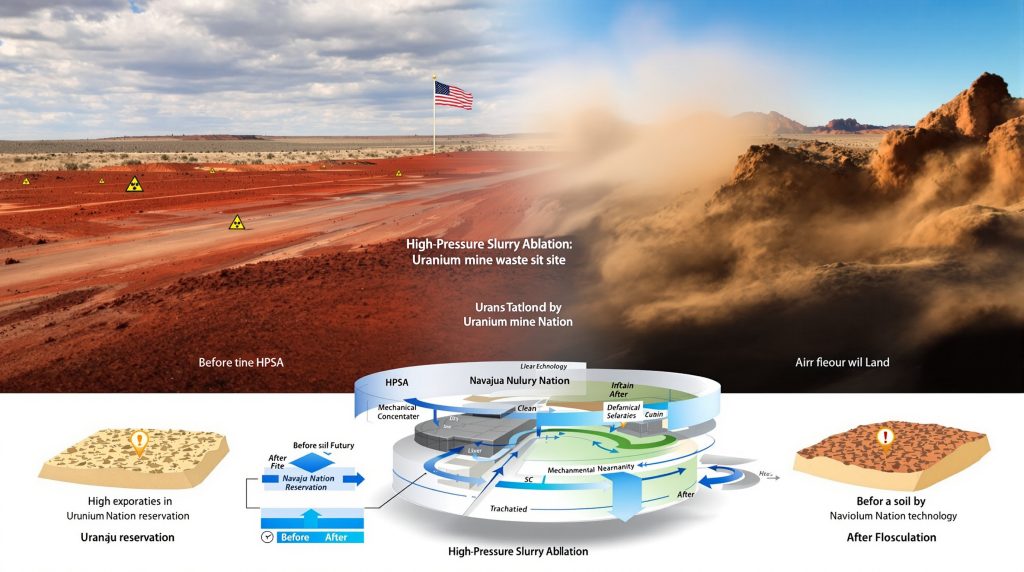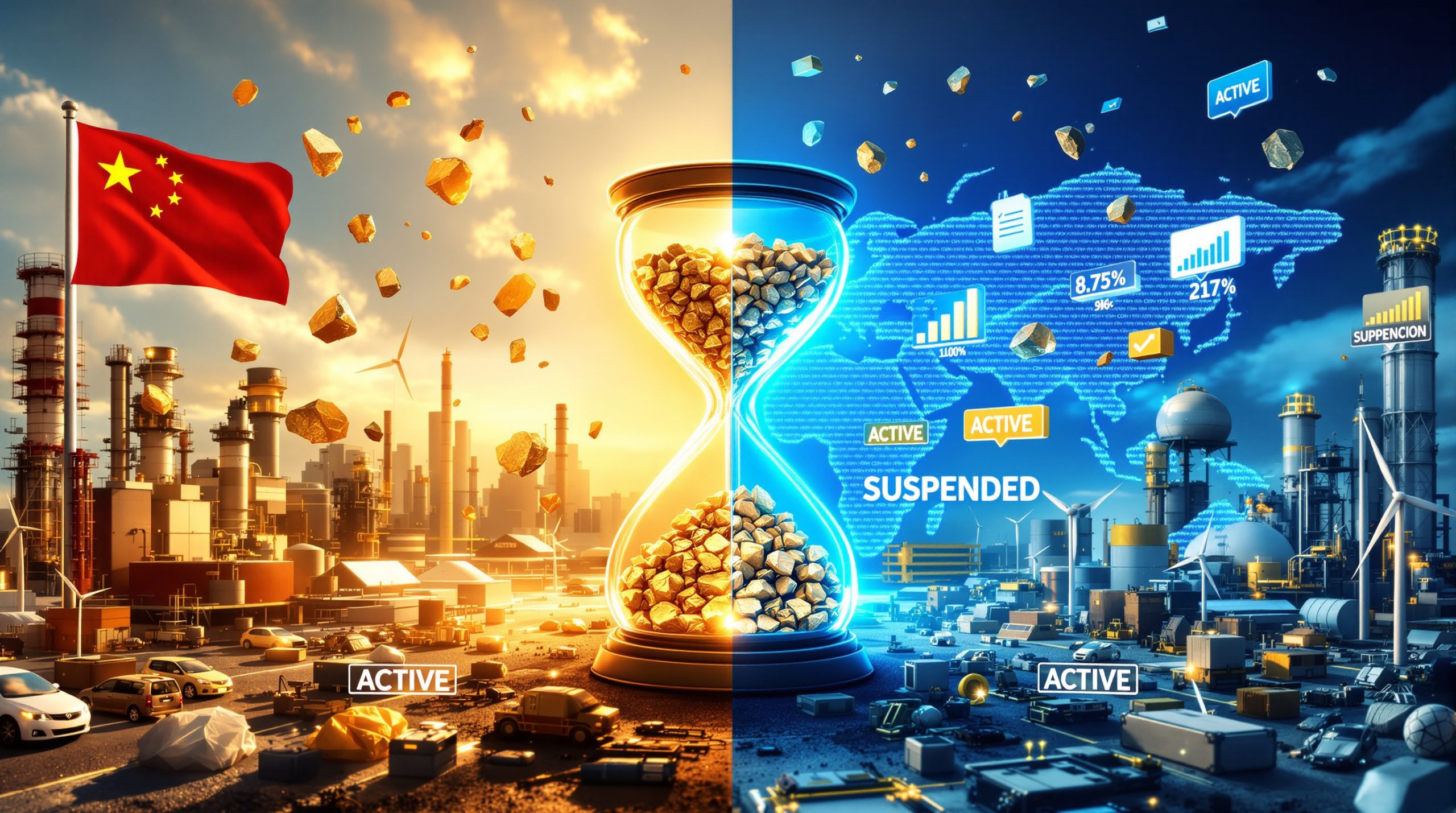How Does Uranium Mine Waste Impact Communities and Ecosystems?
Uranium mining's environmental legacy is one of the most challenging contamination issues facing the western United States today. Over 15,000 abandoned uranium mine (AUM) waste sites remain scattered across the landscape, remnants of Cold War-era operations that have left behind radioactive materials threatening both human health and environmental integrity. These sites represent a particularly acute environmental justice concern, as a disproportionate number are located on or near tribal lands, especially throughout Navajo Nation territories.
According to the U.S. Environmental Protection Agency, approximately 523 abandoned uranium mines exist on Navajo Nation lands alone, creating one of the most concentrated areas of radioactive contamination in the country. The geographic distribution extends primarily across Arizona, New Mexico, Utah, and Colorado, with significant clusters throughout the Colorado Plateau region.
The health implications of this contamination are severe and well-documented. Studies by the Agency for Toxic Substances and Disease Registry have found elevated levels of uranium and other radionuclides in water sources near these sites, with many samples exceeding EPA drinking water standards. This contamination creates multiple exposure pathways, including direct gamma radiation, radon gas emanation, groundwater leaching, surface water runoff, and wind-dispersed contaminated dust.
The Scale of the Uranium Remediation Challenge
The scale of the uranium waste problem is magnified by its persistence. Uranium-238, the primary radioactive component of mining waste, has a half-life of 4.5 billion years, meaning these sites will remain hazardous without intervention for timeframes beyond human comprehension.
The National Research Council has identified this contamination as a multi-generational health concern, particularly for communities that have relied on affected water sources for decades. Tribal populations face disproportionate risks due to both geographic proximity and traditional lifestyles that may increase exposure through cultural practices and subsistence activities.
Traditional cleanup methods have proven prohibitively expensive and logistically challenging. The remoteness of many sites, combined with the sheer volume of contaminated material, makes conventional "dig and haul" remediation approaches economically unfeasible in many locations.
Regulatory frameworks have historically struggled to address innovative remediation approaches for these sites, creating barriers to implementing new solutions. The EPA's Five-Year Plan for addressing abandoned uranium mines on Navajo Nation lands, first established in 2008, represents one of the first coordinated federal efforts to tackle this complex issue, but progress has been limited by technological and financial constraints.
What Makes High-Pressure Slurry Ablation Technology Revolutionary?
High-Pressure Slurry Ablation (HPSA) technology represents a paradigm shift in how uranium contamination can be addressed. Unlike conventional remediation methods that typically involve excavation and off-site disposal of entire volumes of contaminated material, HPSA offers a mechanical solution that processes material at the contamination source.
The technology exploits fundamental differences in mineral hardness to selectively separate uranium from waste materials. Using the Mohs hardness scale (which ranks minerals from 1-10 based on their scratch resistance), HPSA targets specific uranium-bearing minerals by leveraging their different hardness values compared to common silicate and gangue minerals found in surrounding soils and rock.
By processing material on-site, HPSA dramatically reduces the volume requiring specialized disposal—potentially by up to 90%. This volume reduction translates directly into significant cost savings while minimizing transportation risks associated with moving large quantities of radioactive materials across public roadways.
Technical Foundations of HPSA Systems
The core innovation of HPSA technology lies in its mechanical separation approach, which uses particle collisions rather than chemical treatments to segregate uranium minerals. This collision-based process creates less secondary waste and avoids introducing additional chemicals into already-contaminated environments.
The selective mineral liberation mechanism produces two distinct output streams: a concentrated uranium fraction that can potentially be recycled or safely disposed of in much smaller volumes, and a cleaned material stream with significantly reduced radioactivity levels.
The ability to deploy these systems directly at contamination sites represents a major logistical advantage over centralized processing facilities. Mobile HPSA units can be transported to remote locations, enabling treatment of sites that might otherwise remain contaminated due to prohibitive transportation costs.
Beyond uranium remediation, the technology shows promise for processing other critical minerals from both mined ore and legacy waste. This versatility potentially transforms environmental liabilities into resource recovery opportunities, creating economic incentives for cleanup activities.
According to Disa Technologies CEO Greyson Buckingham, HPSA represents "the first scalable method to remediate this waste safely and economically," potentially transforming sites that have been "viewed as a burden too complex and costly to clean up" into manageable mine reclamation innovation projects.
Why Is the Regulatory Framework for Remediation Technology Significant?
The licensing of innovative remediation technologies represents a watershed moment in environmental protection policy. The recent regulatory approval of HPSA technology by the Nuclear Regulatory Commission (NRC) establishes a precedent for how emerging cleanup methods can receive federal validation and deployment authorization.
What makes this regulatory breakthrough particularly noteworthy is the timeline: the NRC completed its review and approval process in just six months, compared to the typical 18-24 month timeframe for similar applications. This accelerated timeline demonstrates how regulatory agencies can adapt to address pressing environmental challenges without sacrificing technical rigor or safety considerations.
The NRC's development of a "clear, first-of-its-kind regulatory framework" specifically for this type of remediation technology creates a pathway for future innovations. Rather than forcing new technologies to conform to frameworks designed for different purposes, this approach tailors regulatory oversight to the unique characteristics and applications of remediation systems.
Regulatory Innovation Timeline
The regulatory process began with the NRC's acceptance of the technology application in April 2025. At that time, regulators established a schedule for detailed technical review, demonstrating a proactive approach to evaluation rather than an open-ended timeline.
The framework development involved creating specialized evaluation criteria appropriate for uranium waste remediation technologies, including performance metrics, safety protocols, and monitoring requirements specific to on-site processing systems.
The expedited review process culminated in October 2025 with formal approval, representing a significant acceleration compared to traditional licensing timelines. This efficiency demonstrates how regulatory bodies can maintain thoroughness while eliminating unnecessary delays.
A key innovation in the licensing approach is the multi-state authorization granted, which allows deployment across multiple jurisdictions under a single federal oversight mechanism. This approach eliminates the need for separate state-by-state approvals, significantly streamlining deployment.
The regulatory process incorporated substantial federal-tribal collaboration, particularly with the Navajo Nation Environmental Protection Agency (NNEPA). This partnership model recognizes tribal sovereignty and environmental protection authority in a way that could serve as a template for future environmental regulatory actions affecting tribal lands.
The high-level engagement of NRC leadership, including Chairman David Wright and Commissioners Bradley Crowell and Matthew Marzano, indicates the significance placed on this regulatory innovation. Their participation in the license approval ceremony underscores the agency's commitment to facilitating environmental remediation solutions.
How Does Technology Licensing for Uranium Remediation Benefit Environmental Justice?
The licensing of advanced remediation technologies directly addresses long-standing environmental justice concerns for communities affected by legacy uranium contamination. By providing regulatory pathways for innovative solutions, these communities gain access to more effective cleanup options that may otherwise remain out of reach.
For decades, tribal communities have borne a disproportionate burden of uranium contamination without access to effective remediation solutions. The development of a clear regulatory pathway for technologies like HPSA represents a significant step toward addressing this historical inequity.
Navajo Nation President Buu Nygren highlighted the importance of this development, stating: "By combining innovative technology with regulatory leadership, we have a new path to remediate legacy uranium sites to restore our lands to safe, productive use and to protect our precious groundwater resources."
Community and Tribal Engagement Models
The licensing process demonstrated a collaborative oversight approach through the direct partnership between federal regulators and tribal environmental authorities. The NNEPA's involvement as a federal partner represents an important recognition of tribal sovereignty in environmental decision-making.
The broad stakeholder coalition supporting the licensing effort included diverse environmental, energy, and community organizations. This coalition-building approach ensured that multiple perspectives were considered throughout the regulatory process.
A central priority of the remediation approach is land restoration—returning contaminated areas to safe, productive use for affected communities. This focus recognizes that contamination represents not just a health threat but also an economic and cultural loss when lands cannot be safely accessed or utilized.
The emphasis on groundwater protection acknowledges the critical importance of water resources, particularly in arid western regions where many abandoned uranium mines are located. For tribal communities, protecting "precious groundwater resources," as described by President Nygren, represents both an environmental and cultural imperative.
The initiative has garnered bipartisan political support, with participation from legislators across the political spectrum. This cross-party recognition demonstrates the importance of addressing legacy contamination as a national priority transcending partisan divisions.
The involvement of organizations like Native Nuclear (formerly the Tribal Consent-Based Coalition) demonstrates the growing role of tribal advocacy organizations in shaping environmental policy. These groups provide critical perspectives on how remediation approaches align with tribal priorities and values.
What Economic Opportunities Does Uranium Waste Remediation Create?
Beyond environmental benefits, licensed remediation technologies create significant economic opportunities through resource recovery, land reclamation, and cost reduction. These technologies transform environmental liabilities into potential assets through several economic pathways.
The ability to extract and recycle uranium from waste materials creates direct resource recovery value. This recycling potential means remediation can generate recoverable materials that offset some cleanup costs while contributing to domestic energy resource supplies.
The dramatic reduction in waste volume achieved through selective processing technologies like HPSA translates directly into disposal cost savings. With specialized radioactive waste disposal costs running into thousands of dollars per cubic yard, reducing volumes by up to 90% represents substantial economic benefit.
Resource Recovery Economics
The HPSA technology's ability to produce a uranium concentrate stream opens possibilities for recycling uranium that would otherwise remain environmental waste. This extraction represents a potential "urban mining" opportunity, recovering valuable materials from legacy contamination.
Beyond uranium, the technology shows potential for recovering other critical minerals that may be present in mine waste. As noted by Disa, the process can "upgrade critical minerals from both mined ore and legacy waste," potentially creating additional resource streams.
The significant reduction in disposal costs comes from both decreased volume and potentially lower waste classification levels. By separating concentrated uranium from bulk materials, the remaining cleaned material may qualify for less restricted disposal pathways or potential beneficial reuse.
Land value restoration represents another economic benefit as contaminated properties can be returned to productive use after remediation. This restoration potentially allows for agricultural, cultural, recreational, or even renewable energy development on previously unusable land.
The supply chain implications of domestic uranium recovery from waste could contribute to energy security goals. As the United States seeks to reduce reliance on imported uranium for its nuclear fleet, even modest contributions from recycled sources could support supply diversification efforts, especially given recent concerns about uranium market volatility and the US uranium import ban.
On-site processing dramatically reduces transportation requirements and associated costs. Traditional remediation approaches often involve shipping large volumes of contaminated material long distances to specialized disposal facilities, creating both economic costs and environmental impacts from transportation activities.
How Does the Licensing Process Work for Remediation Technologies?
The regulatory pathway for remediation technology licensing involves multiple stages of technical evaluation, safety assessment, and operational protocol development. Understanding this process is crucial for future technology deployment and regulatory engagement.
The NRC's licensing process began with acceptance of the application, which occurred in April 2025. This acceptance marked the formal start of regulatory review and established a defined timeline for evaluation.
Upon accepting the application, the NRC "set a schedule for a detailed technical review" and "developed and deployed a clear, first-of-its-kind regulatory framework" specifically for this technology type. This approach demonstrates regulatory adaptation to novel technologies rather than forcing innovation into pre-existing frameworks.
Key Components of the Licensing Framework
The technical evaluation criteria likely included specific performance metrics for demonstrating remediation effectiveness. These metrics would establish how the technology must perform to achieve regulatory objectives for contamination reduction.
Safety protocol development formed a critical component of the licensing process. These protocols established operational guidelines to ensure worker and community protection during remediation activities.
Environmental impact assessment is a standard component of regulatory review, evaluating potential secondary environmental effects from the remediation process itself. This assessment ensures the solution doesn't create new environmental problems while addressing existing contamination.
The licensing established clear operational boundaries, delineating authorized activities and limitations for technology deployment. These boundaries define where, how, and under what conditions the technology can be operated.
Monitoring and reporting requirements ensure ongoing verification of remediation performance. These requirements create accountability mechanisms to confirm the technology continues to perform as expected after deployment.
The regulatory framework development benefited from Disa's experienced regulatory team, including Stephen Cohen (Chief Regulatory Affairs Officer) and Jeff Merrifield (Board Member and former NRC Commissioner). This regulatory expertise likely facilitated effective navigation of the approval process.
The multi-state authorization granted in the license allows deployment "under federal oversight to treat abandoned uranium mine waste across multiple states." This approach creates regulatory efficiency by eliminating the need for separate state-by-state approvals.
The six-month timeline from application acceptance to approval represents a significant acceleration compared to the traditional 18-24 month timeframe for similar applications. This efficiency demonstrates how regulatory bodies can maintain thoroughness while eliminating unnecessary delays.
What Role Do Public-Private Partnerships Play in Remediation Technology?
The successful licensing of remediation technologies often depends on effective collaboration between private technology developers, government agencies, academic institutions, and affected communities. These partnerships leverage diverse expertise and resources to address complex environmental challenges.
The licensing of HPSA technology "builds on years of collaboration among federal and tribal partners," demonstrating the importance of sustained partnership development. This collaborative foundation likely created the trust and shared understanding necessary for regulatory success.
Disa CEO Buckingham acknowledged the critical role of partnerships by expressing "gratitude to key stakeholders including the NRC's Chairman and Commissioners, the senators of Arizona and Wyoming, and Navajo Nation leadership" for their support. This recognition highlights how diverse stakeholder engagement contributes to regulatory success.
Collaborative Development Models
The technology licensing process benefited from a remarkably diverse stakeholder coalition that included tribal leadership, environmental organizations, nuclear energy advocates, community groups, academic institutions, and bipartisan congressional support. This broad-based coalition demonstrates how effective partnerships can bridge traditional divides between environmental, energy, and community interests.
The federal-tribal partnership, particularly with NNEPA as a formal partner, represents a government-to-government collaboration model that respects tribal sovereignty while leveraging federal regulatory authority. This approach creates a balanced governance structure for addressing contamination on tribal lands.
Political engagement at multiple levels, including Senator Cynthia Lummis's (Wyoming) participation in the approval ceremony, demonstrates the importance of state-level support for remediation efforts. State governments often play crucial roles in implementing federally-approved technologies.
Academic partnerships, referenced through the involvement of "academic leaders from several US universities," likely provided technical validation and scientific review to support the regulatory process. These partnerships bring credibility and research capabilities to technology development efforts.
The involvement of policy organizations like ClearPath Action, Third Way, and the Nuclear Innovation Alliance suggests a role for policy advocacy in facilitating regulatory innovation. These organizations can help identify and address policy barriers to technology deployment.
The engagement of community-focused groups like Generation Atomic and Native Nuclear indicates a bottom-up approach to building social license for remediation technologies. Community acceptance is often as important as regulatory approval for successful technology deployment.
What Are the Future Applications of Licensed Remediation Technologies?
Technologies initially licensed for uranium remediation may have broader applications for addressing other environmental contamination challenges, creating a multiplier effect for their environmental and economic benefits.
The HPSA technology's mechanical separation approach, based on Mohs hardness differentials, potentially applies to a wide range of mineral separation challenges beyond uranium. This versatility could open applications in other radioactive waste scenarios, heavy metal contamination, and mining waste remediation.
The technology's demonstrated ability to "upgrade critical minerals from both mined ore and legacy waste" suggests potential applications in resource recovery from diverse waste streams. As critical mineral supply concerns grow globally, technologies that can extract these materials from waste become increasingly valuable.
Expanded Application Potential
For other radioactive contamination scenarios, the technology could potentially be adapted to address sites contaminated with different radionuclides. The mechanical separation approach might work effectively for various radioactive elements with similar physical characteristics.
Heavy metal remediation represents another potential application area. Many mining sites suffer from multiple metal contaminations (lead, mercury, arsenic, etc.), which might be addressable using similar mechanical separation principles.
The mining industry could potentially integrate these technologies into active operations for waste reduction and resource recovery. Rather than creating new contaminated sites, proactive application could minimize environmental impacts from current mining innovation trends.
International technology transfer opportunities exist for deploying these remediation approaches globally. Many countries face similar legacy contamination challenges from historical uranium mining and could benefit from proven remediation technologies.
Climate resilience integration represents an emerging opportunity, as remediation technologies could be incorporated into broader environmental restoration efforts that enhance ecosystem adaptation to climate change impacts.
The on-site processing capability allows remediation of remote or difficult-to-access sites that might otherwise remain contaminated due to logistical challenges. This accessibility could help address contamination in areas previously considered too isolated for effective cleanup.
The reduced waste volumes achieved through selective processing technologies could help address disposal capacity limitations that currently constrain remediation efforts. By dramatically reducing material requiring specialized disposal, more sites could be addressed with existing disposal infrastructure.
How Do Remediation Technologies Compare to Traditional Cleanup Methods?
Understanding the advantages and limitations of licensed remediation technologies compared to conventional approaches helps stakeholders make informed decisions about cleanup strategies.
Traditional uranium mine waste remediation typically involves excavation and transportation of contaminated materials to licensed disposal facilities. This approach, while straightforward, creates significant challenges related to transportation risk, disposal capacity, and cost.
HPSA technology represents a fundamentally different approach by processing materials on-site to separate uranium from bulk materials. This selective processing creates distinct advantages in several key operational areas.
Comparative Analysis Framework
The processing location represents a fundamental difference between approaches. Traditional methods typically require off-site processing at specialized facilities, while HPSA enables on-site deployment. This difference eliminates many transportation challenges and associated risks.
Waste volume reduction capabilities vary dramatically between methods. Traditional approaches generally result in minimal volume reduction, while HPSA technology can achieve up to 90% volume reduction by selectively concentrating uranium.
Resource recovery potential differs significantly as well. Traditional methods offer limited to no resource recovery, while HPSA creates uranium recycling potential and possible recovery of other valuable minerals.
Implementation timelines show substantial variation, with traditional methods often requiring years to decades for completion, while selective processing approaches can potentially reduce timelines to months or years for comparable sites.
Cost structures differ in important ways, with traditional methods involving high transportation and disposal costs, while HPSA involves higher upfront technology costs but potentially lower long-term expenses due to reduced disposal volumes.
Environmental impacts vary between approaches, with traditional methods requiring extensive material movement and associated transportation emissions, while on-site processing minimizes the transportation footprint.
Community disruption levels differ as well, with traditional large-scale excavation and hauling operations potentially creating significant and extended community impacts, while on-site processing can reduce both the duration and scale of disruption.
What Are the Implementation Challenges for Licensed Remediation Technologies?
Despite regulatory approval, the deployment of innovative remediation technologies faces practical challenges that must be addressed for successful implementation.
Scaling from demonstration to full commercial deployment represents a significant challenge for any new technology. While HPSA has received regulatory approval, expanding operations to address thousands of contaminated sites will require substantial scaling of equipment, personnel, and operational capabilities.
Site-specific variations in contamination characteristics will necessitate adaptation of the technology for different geological and contamination scenarios. No two abandoned uranium mine sites are identical, requiring flexible implementation approaches.
Operational Implementation Considerations
Scale-up requirements involve not just equipment multiplication but also organizational capacity building. Moving from initial deployments to widespread implementation requires development of supply chains, maintenance networks, and operational protocols.
Site-specific adaptations will be necessary as the technology encounters varying uranium mineralization, soil types, and contamination patterns. The ability to adjust operational parameters for local conditions will be crucial for consistent performance.
Workforce development represents a significant challenge, as specialized training will be required for system operators, maintenance personnel, and site assessment specialists. Building this specialized workforce takes time and investment.
Infrastructure needs, including power supply, water access, and support facilities, must be addressed for remote site operations. Many abandoned uranium mines are located in areas with limited existing infrastructure.
Financial mechanisms for funding large-scale remediation programs remain a critical challenge. While the technology may reduce costs compared to traditional methods, securing adequate funding for addressing thousands of sites still requires robust financial structures.
Performance verification through long-term monitoring will be essential to confirm cleanup effectiveness. Establishing appropriate monitoring protocols and maintaining surveillance over time ensures remediation goals are achieved and maintained.
Public acceptance and stakeholder education will remain ongoing challenges, particularly in communities with historical distrust of mining companies or government agencies. Transparent communication about technology capabilities, limitations, and safety features will be essential for building trust.
Regulatory coordination between federal, state, and tribal authorities will require attention as implementation expands. While the NRC license provides federal authorization, coordination with other regulatory entities will be necessary for smooth deployment.
FAQ: Technology Licensing for Uranium Remediation
What exactly does the NRC license allow remediation companies to do?
The license permits the deployment of High-Pressure Slurry Ablation systems to treat abandoned uranium mine waste across multiple states under federal oversight. Companies can operate these systems at contamination sites following specific safety and operational protocols established in the licensing process.
How does HPSA technology differ from traditional uranium waste cleanup methods?
Unlike conventional methods that typically involve excavation and off-site disposal, HPSA uses a mechanical process that separates uranium from waste material on-site. This approach reduces the volume requiring specialized disposal by up to 90% while enabling potential resource recovery, significantly reducing transportation requirements and associated risks.
What environmental benefits does licensed remediation technology provide?
Licensed technologies offer more effective contamination removal, reduced transportation requirements, decreased disposal volumes, groundwater protection, and the potential to restore land to productive use. The on-site processing approach minimizes the environmental footprint of the remediation process itself while addressing the underlying contamination.
How do tribal communities benefit from these remediation technology licenses?
Tribal communities gain access to more effective cleanup options for contaminated lands, protection of water resources, potential economic opportunities through land restoration, and a more collaborative role in environmental decision-making affecting their territories. The licensing process incorporated tribal environmental authorities as formal partners, respecting tribal sovereignty.
What makes the recent licensing approach different from previous regulatory frameworks?
The new approach features an expedited review process (6 months versus 18-24 months), a specialized evaluation framework specifically developed for remediation technologies, multi-state deployment authorization under a single license, and greater collaboration between federal regulators, tribal authorities, and technology developers.
Can the recovered uranium be used for energy production?
Yes, the uranium concentrated through the remediation process can potentially be recycled for use in nuclear fuel. This resource recovery aspect transforms an environmental liability into a potential contributor to domestic energy supply, though the quantity and quality of recoverable uranium will vary by site.
How does the technology protect workers and nearby communities?
The licensing process established specific safety protocols for system operation, including controls for dust management, radiation protection, and material handling. The on-site processing approach also reduces transportation of contaminated materials through communities, minimizing potential exposure pathways.
What happens to the cleaned material after processing?
After uranium is removed, the remaining material has significantly reduced radioactivity levels. Depending on site-specific characteristics and regulatory requirements, this material may qualify for less restricted disposal pathways or potential beneficial reuse in certain applications, subject to verification of cleanup effectiveness.
How many abandoned uranium mine sites could potentially be addressed with this technology?
With over 15,000 abandoned uranium mine waste sites across the western United States, the potential application is extensive. The technology's scalability and on-site deployment capability make it suitable for addressing contamination in remote locations that might be impractical to remediate using traditional methods.
What role does the federal government play in implementing these technologies?
The federal government provides regulatory oversight through the NRC license, which establishes operational parameters and safety requirements. Additional federal involvement may include funding support through various environmental cleanup programs, technical assistance through agencies like EPA and DOE, and coordination with tribal governments on sites affecting tribal lands.
Worried About the Environmental Impact of Uranium Mining Waste?
Discover how new High-Pressure Slurry Ablation technology is revolutionising uranium mine waste remediation by visiting Discovery Alert's dedicated discoveries page, where our proprietary Discovery IQ model identifies breakthrough innovations transforming environmental challenges into investment opportunities.




